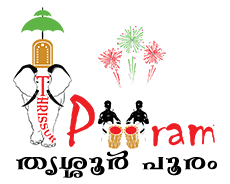Latest News
Temples
Sree Vadakkumnathan Temple
The principle deity is Siva (Vadakkumnathan)
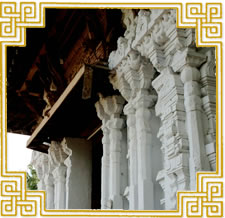
The idol is not visible, as it is covered under 3-5 meter high and 5-7 meter wide mount of ghee, formed by daily abisheka (ablution) with ghee over centuries.
In spite of high temperature, ghee does not melt, no insects & the collection is preserved as good as new even after centuries. It is believed that lord Siva (Kiratha) had a head injury during his fight with Arjuna and lordDhannuandhara moorthy (Lord of Auyurveda) prescribed ghee ablution.
Outside this nalambalam the temple theater, known as "Kootthambalam" is situated. Exquisite vignette carved in wood, beautiful wooden pillars, acoustic treatments - this is an engineering marvel has no parallel anywhere else in the world. There was practice followed by carpenters to keep a small chisel at the most important place of the structure It is predictive that there is something wrong or the urgent maintenance is due if the chisel falls down. And the chisel fell down during the year 1875 AD and Mr. Vellinezy Jatadevan Nampoothiri remodified this in 1880. More than 410 Sq.m. built area, this is biggest of this kind. The 41 day special program of "Koothu" (mythological story telling) and "Koodiyattom" (ancient form of dramatic dance) is performed here annually.
Mural Painting of dancing lord Siva with 16 hands is an amazing work of Madhurangattu Namboodiri. The fifteen hands are holding different armaments and last is holding a flag post with flag. While one leg is pressing the embodiment of papa (Apasmaramoorthi) and the other one is in elevated form. The moment the last touch (Opening the Eyes) was over the picture started to dance - according to a legend. Another mural is the Vasuki Shayanam (Siva). (exactly like Ananthasayanam where lord Vishnu rests on Ananatha) The sculpture of large bullock (Nandikeswara) which is also there in thenalambalam. These are worshiped regularly along with sapthamathrukkal (seven goddesses)
Some Interesting Rituals
Before concluding day pooram, the deities ascending through southern gopuram will travel up to the statue of erstwhile Maharaja of Cochin in front of the Corporation office. There was a custom a team of merchants from market will receive the deities from the swaraj round and will lead to the market. This "Angadi Kanikkura" was a way of seeking the blessing. To commemorate this custom is followed. Version is also that "Nairangadi" was residential area once and the dietis travel to "prayeduppu".
Nilapadu thara: In front of eastern gopuram of vadakkumnathan some 10 meters towards north there is an elevated place which is called "niladthara". Earlier the representatives of Cochin dynasty used sit here and watch the pooram. Now it turned the finishing point of the pooram.
Vadakumnathan Temple, some Popular Legends
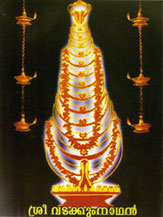
Vadakumnathan is one of the 108 Sivalayas consecrated by Saint Parasurama. Since Devi Parvathy was alongside Siva when he gave darsan to the saint, Parvathy was also installed facing east in the temple. Lord Vigneswara and Lord Sreerama were also added to complete the installation.
The mode of dharsan for this temple was formatted by the saint Adi Sankara, who in turn was a born to his parents for their Tapsya at this temple. This dharsan order is still followed without alternations.
Arjuna's Villkuzhi: During the Mahabharata war Jayadra was killed by Arjuna to retaliate his son Abhimanyu's heroic death trapped in "chakra view-ha". Jayadra was an ardent devotee of Lord Siva and hence the arrow that killed him fell in to the Vadakumnathan temple courtyard. As per Sree Krishna's advice, Arjuna prayed to lord Siva and was condoned of his sin for killing Jayadra. A deep well was formed where the arrow fell and legend says that Arjuna cleaned his arrow with the water from this well. It is customary to wash your feet with water from this well before starting dharsan in this temple. Few meters away from this villkuzhi, towards north there are two granite pillars. Samorin of Calicut paid an offering "gold thulabharam" to Vadakumnathan .To perform this offering (articles weighed against one's own weight) this giant pillars were made.
Gosalakrishna: Saint Villuamangalam who has having a close rapport with all deities, once noticed a hallo on the northern side of the temple, which then slowly turned into a cowherd and cows. The saint felt the presence of lord Krishna and as per Villuamangalam direction the Gosalakrishna temple was built.
The Hrishba temple: is located on north-west side of the northern entrance. Carved out of fine granite stone the idol is a bullock in sleeping posture. Earlier, the bullock was in standing position and was worshipped from the front side (east). One morning the idol was found lying and later front door was closed and instead side view was opened. Since the idol is a sleeping deity, the Hrishaba should be worshipped after waking him up by clapping your hands. A piece of thread from your dhoti is to be presented as an offering to the God to cover up his nakedness. There is a school of thought that the idol is of "Digambra" of Jainisam. After completing his duties Saint Parasurama disappeared at the north east corner of the temple (eesana cone - north-east corner), where you will see a small area earmarked with walls and lightened with a lamp. The kings, the arch enemies of the saint, used avoid this holy place hence the nearby bypass.
Simhodara Temple: Next to the eastern pathway connecting the east gopuram lies "Simhodara" temple. Simhodara is the trusted lieutenant of lord Siva and is guarding the main Siva temple, by watching the "thazikakudom" (There is a hole - triangle in shape - in the main wall, through which you can have the dharsan of the temple's "Thazhikakudam"). The real name of this deity is "Sarvaka" who was a student of wrestling to Nandikeswara (the holy bullock). During the trail the central part of the body of sarvaka was elongated and the name simhodara (belly of lion). Lord Siva agreed to be in Kerala as per the request of saint Parasurama and Sarvaka was deputed to find a suitable place. Sarvaka travelled all over and found all are suitable places. He was tired from the journey and was taking rest when Lord Siva came along with Devi. He kicked Sarvaka to the present place (kadikuzhi- the drainage).
An ardent devotee of Vadakumnathan used to pray for a humble request to have dharsan of Kasi Viswanatha. As per the recommendations from Sree Parvathy, lord made a direct tunnel to Kasi and invited the devotee to travel along with. The moment they touched Kasi, Sree Parvathy requested Simhodara to close the tunnel (you will see a balikallu here to mark the spot). It is believed Sree Parvathy had a second thought that Ganga may use this tunnel. The devotees are advised to put a stone as a helping hand to the closure. However this practice was banned as per a devaprasana, recently.
Sambuthara: This is the platform at south east corner where you salute Lord Chidhambara by facing east and Lord Rameshwara by facing south. Lord Siva used to dance as "Nadaraja" (King of Dance) in Chidambaram which is reflected in Rameswaram as well. As per Nandikeswara's (the holy bullock) advice, Anantha, the 1001 headed Serpent king watched the shadow - sitting on this platform - of this dance and was blessed to notice the same at the entrance of the sanctum sanatorium of Vadakunnathan temple as "Nirtha Nathan".
Amma thara: Here we salute "Oorakathamma" and "Sree Koodalmanikyaswamy (Sree Bharatha)". A part of the holy spirit of Sreekamakshi accompanied the ardent devotee Thiruvalayannur Bhattathiri (Poomulli Namboothiri) to stay near Sree Parvathy at Vadakunnathan premises. Yielding to the prayers of Bhattathiri, Kamakshi was allowed to settle at Oorakam, which is located at around 10 KM southwards, as Oorkathamma. Similarly the idol of lord Bharatha was to be installed adjacent to Sreerama temple. But as per the humble prayers of Vakayil Kaimal the idol was installed at Irinjalakuda, 20 km southwards of Vadakunnathan. It is believed that every day both Sreevparvathy and Sreerama pay a visit to this Ammathara to see their sister & brother respectively.
Kali sila: Kali sila, the small stone kept within the walls of the temple, is gradually growing in terms of height and when it reaches the height of the western gopuram, the Kaliyugam ends. To prevent this devotees throw the balance of the Sivaprasad on it.
On "Thrikarthika" day, Sri Villuamangalam found Lord Siva sitting on the compound wall adjacent to the southern gopuram. The almighty was enjoying "Karthika vilakku" of Kumaranellor. Till then one pooja to lord Siva is done here on Karthika day.
Main shrine: While entering the main shrine, just behind the Nandi and on the northern wall is a rare mural painting. It is "Vasuki sayana". Vasuki is the serpent king and the garland of lord Siva. Here lord Siva is lying on Vasuki (as Lord Vishnu on Anantha).
Lord Sankaranarayana is also called Madhyanathan (Lord of center - may be because it is in the center of Rama & Siva temple). As per the rule we have to pay dharsan 4 times to both Siva and Rama temple. But to Sankaranarayana it is 6 times. There is no practice to give any type of prasadam from this shrine.
However Lord Sankaranarayana is the custodian of all movable and immovable assets of Vadakunnathan temple.
Temple: The newly wed couples - Sree Rama & Seetha - was blocked on their way to Ayodhya from Midhila by Parasurama. Sree Rama defeated Parasurama and the saint donated all his powers to Sree Rama. Sreerama was travelling by the chariot given by lord Sun, so devotees pay respect to soorya (sun) at the south side of the temple. Devotees pay respect to Nrsimha portrait on the wall.
Ganapathy Temple (Venmadakoil): Vadakkumnathan had 12 day utsavam during "Uthrayana" season and discontinued due to various reasons. Once the coffer was empty and the "Yogadirippad" had an oracle to remove the Ganapathy idol. A dark room (nilavara) was found below the peetam and a golden lizard lightening the whole place. The room was full of gold and jewels. The chieftain took only whatever needed to conduct utlsavam. You will see a stone carving of the lizard to commemorate this.(behind the left door to the main entrance of the Valiyambalam). Touch and pray for the prosperity here. There is a mural painting near the sopanam of the Lord Siva temple. It is the "sundra yakshi" (Beautiful apsara). If you touch and pray on this portrait, this charming young lady will marry you.
Northern Gopuram: On close observation you may find that the Northern gopuram of Vadakumnathan Temple is slightly leaning. There is a legend behind this too. Once upon a time, a small golden serpent was found in a bell of the Namaskaramandapa of Vadakumnathan and Karrat Namboodhiri tried to pull it down to win a bet. The tail of the serpent started growing beyond the temple pushing away the Namboodhiri. Finally Karrat found asylum in the pond (kokarni - near to north gopuram). Chasing serpent covered the pond and the Namboodhiri had no choice but to beg for help from "Garuda". When Garuda came and took position on the northern gopuram, the serpent (who was actually Vasuki) vanished. The gopuram could not carry Garuda's weight and started to lean and the king of birds flew away.
Eastern Gopuram: The chief priest of Vadakumnathan used to do some secret pooja after daily routine in a room in this gopuram. It is rumored to be black magic and as per Maharaja's order an employee peeped through a hole in the door to verify this. It was just "Bhagavathy Seva" and during the climax of the pooja, employee saw an amazing power source, which as per the legend blinded him. The room remained closed for decades.
Southern Gopuram: Southern Gopuram is a donation from King of Kodugallore and hence devotees pay their salute to Kodugallore Devi here. To pass through this gopuram is said to be a journey of no return. In olden days, the convicts, who were sentenced to death, were brought to Sankaranarayana Temple for their last rites. They were made to wear red garlands and would later be handed over to "Arachar" waiting outside the southern gopuram. The sentence was performed at a place called Anchery, some 6km south east of Vadakumnathan. However the doors of this gopuram are now opened only for Thrissur pooram. "Neithilkavilamma" a participant pooram deity opens this door from outside on the day before pooram and will be closed the Thrissur pooram day after the royal dharbhar "Thekkottirakkam".
Western Gopuram: The western gopuram was constructed by the Perumppadappu Swaroopam of Cochin dynasty. The "deepasthambham" was donated by Samoothiri of Calicut as a token of compromise between Perumppadappu and Calicut.
Sree Kurumbha Temple (Sree Temple/Kodungallur Temple)
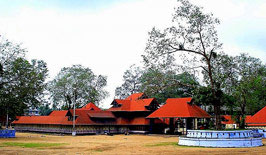
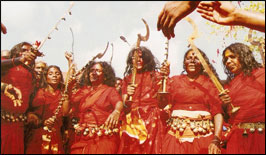
This is the base temple of 64 primary and other 100 and odd kali temples in Kerala. The temple is built for the legendary "Kannaki" of "Chilapathikaram" during second century A.D. (Chera Dynasty) as per legend. The pooja is through unique tantric style "Rurujithth vithanam". This tantric branch is highly sophisticated and calls for skill, meditation and dedication of the "Thantri". Accordingly "Siva" is installed facing east and "Chamundi" is installed facing west (not directly facing slightly shifted to south words) or facing east. "Sapthamatrekkal" (seven mothers, with the invisible presence of Kausikeedevi) is installed facing north adjacent to chamundi temple. The chamundi temple is closed and Adi Sankara installed Sree Chakra(sree meru chakra) here. The combination of 4 triangles(Siva chakras) and 5 inverted triangle (sakhti chakras) is a mathematical puzzle which reveals secrets of the ultimate universe and modern science could not find its equation. All poojas are done on a base, in front of the chamundi of the sapthamatha temple. Vigneswara temple and vasoorimala other deities The "vasoorimala" (smallpoex devi) is supposed to be very power full deity and the main offering "Gurthi" is done here. There is another deity called "thavittumuthy" where there is no pooja. All can offer boiled rice powder over the idol. The 12 feet stone vigraha of the Kshetrapaln (Roughly translated as temple chief Security officer - here it is Lord Siva) is the biggest in Kerala.
The Bharani festival is during March - April and the "Thalapoli" is during mid January (seven days). The "oracles" of 200 odd temples spread over kerala after travelling their respective "Thattakams" (domains) reaches to Kodungallur Temple during "Bharani". The oracles will enter the temple chanting "obsene" songs and beating the temple roof with sticks.
Guruvayoor Temple
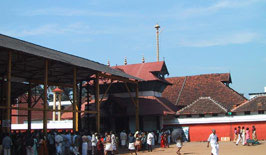
One of the 10 paradises in the world, Guruvayoor temple is located 29kms from Vadakumnathan.
The idol of Guruvayoor temple is considered to be extremely sacred since it is carved out of "Pathalanjana Sila". The idol was once worshipped by lord Mahavishnu in Vaikunda and handed over to Bhrama. Later the idol was passed through the sacred hands of Sutaps, Kasypa, Vasudeva and finally to Lord Krishna, who installed it at Dwaraka. At the time of "Swargaarohana" (his heavenly abode) Krishna requested "Udhava" to install this vigraha at a suitable place. Lord Siva pointed out the place adjacent to "Rudra theertha". The place was sacred since under the waters of this Rudrathreetha Lord Siva worshipped Mahavishnu and emerged out and revealed "Rudra geetham" a hymn praising the lord Mahavishnu "Brihaspathi" (the deva "guru") and "vayu" (the god of winds) installed the idol at this place and the place is called "Guruvayoor"(oor means place). At the time of installation Lord Siva along with Devi Parvathy was present. Siva moved further north due to lack of space and it is Mamiyoor Siva temple.
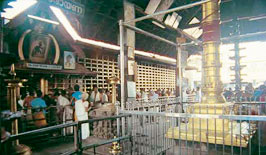
Lord "Mahavishnu" gave darsan to Vasudeva in the jail as "Bal Vishnu" and thus the concept of baby boy Unnikrishnan the legend. The concept was popularized by Poet "Poothanam" through his famous stanza "who need another kid when Unnikrishnan is with in my heart?". Another poet "Melpathoor" and ardent devotee "Kurooramma" made this temple famous. Punnathoor Kotta - the elephant park some 3 Kms away from the temple where more than 65 elephants of Lord Guruvayoorappan is kept in natural ambience. Vrindavan Estate at vengad about 55 km from Guruvayoor at Malappuram (Dist) around 550 cows is looked after by the devaswom Guruvayoor Ekadasi & Chembai Sangeethotsava.( Music Festival). The Ekadasi, falls during Nov / Dec. months, is the day Lord Sree Krishna imparted Sreemat Bhavad Geetha to Arjuna at the battle field of Kurushetra. The 15 day long music festival, which last till the ekadasi night is in commemoration of Chembai Vaidyanatha Bhagather who was a doyen of Karnatic music. Bagavather was an ardent devotee of lord Guruvayoorappan and used to offer his music recital on the Ekadasi day till he left his heavenly abode.
From morning 5.30am. till night 11 - various forms of Opatsana, vocal, instrument, Kacheri - goes on uninterrupted Many well known exponents of Karnatic music participate regularly in the festival as an offering to Lord and live telecasted by visual medias and broadcasted by AIR. It is almost a replica of Saint Thyagaraja festival. The highlights of the Festival is group singing of saint Thyagaraja's Pancharatna Krithis on Dasami day by several leading artists
Phone :
Temple: +91-487-2556680
office: +91-487-2556335,2556346, 47,
Web: www.guruvayoordevaswom.com
Dhanwanthari Moorthi temple

This rarest temple of Dhanwanthari moorthi (god of aurveda) is on Wadakkancheri - kunnamkulam route. Sub-Deities are: Siva, ayyappa, Ganapathy and Vaaraha. This is the family deity of the "Ashtavaidyas" of this area(kuttenchery moosad etc). The Ekadasy of Malayalam month of Dhanu (Vaikunda Ekadasy) is the important day to this temple. Along with kilometers long queue of the devotees a parallel queue of elephants is the added attraction of the day. The "mukkudi" the main offering to the lord (a mix of curd, pepper powder, turmeric powder and salt) is believed to be the best preventive medicine to all diseases.
Triprayar Sree Rama Temple

Shree Rama Temple is Hindu temple situated in Triprayar in Thrissur district of Kerala state in India. The deity is Shree Rama and with four arms with bearing a conch, a disc, a bow and a garland. The temple is situated on the bank of river Theevra. The Temple deity is the presiding deity of Arattupuzha Pooram.
Triprayar temple used to be owned & administered by the 3 famous namboodiri families namely cheloor Mana janappilly Mana & Punnappilly Mana before it was handed over to the Cochin Devaswom Board. Still, the heads of these three families serve as the Ooralans of the temple and takes part in the rituals & festivals in accordance with the customs.
Sree Koodalmanikyam Temple
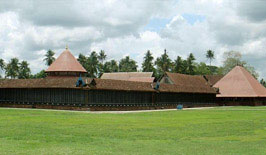
The temple is situated at Irinjalakuda 25 km south west from Vadakunnathan. The overjoyed "Baratha" eagerly waiting for the return of his beloved brother Sree Rama from exile is the pratishta sankalapa of this temple. The tantric practices, Rituals, methodology of offerings are distinct.
Three Poojas Ethirettu Pooja Ucha Pooja, Athazha Pooja and no Siveli The floral offerings to the deity consist of Lotus, Tulasi and Chethi. No other flower is taken for Pooja or for making garlands and thetchi (ixora) and thulasi (ocimum sanctum) etc not grown in the compound. Incense sticks and camphor are not used for the pooja. There are no sub deities in this temple. The temple pond is also unique as but fish no other aquatic creatures are not available. The tallest flag post (kodimaram) in kerala and second biggest "Kootahbalam" belongs to koodalmanikyam. The 11 day long "Thiru ultsava" is the heavenly feast to art lovers of all branches.
The 17 caparisoned elephants with 140 odd artists performing "panchari" with in the four walls of the temple is an enchanting experience. All the classic temple art forms like kathakali, koodiyattom, chakkyarkoothu, ottamthulal are performed during these festivals
Moozhikulam Temple
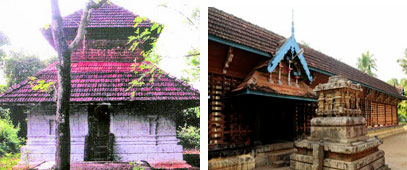
This temple dedicated to Sri Lakshmana is a rarest temple. Situated near the mala-alwaye route, 30 KM, away from Koodalmanikyam temple to words south - east direction. As per legend, pleased by the penance and meditation of Haritha maharshi Lord Mahavishnu gave some advices to the rishi. These advices considered to be "Thirumozhi" (sacred words) which named the place "thirumozhikalam". Kalam which means stage, turned to kulam and mozhi to moozhi in due course. Hence Thirumoozikulam. This a multi-shrine temple with Dakshinamoorthy, Sreerama, Sita, Vigneswara, Hanuman, Sastha, Bagavathy and Gosala Krishna.
Sathrugna Temple - Payemmal.
This temple is about seven kilometers away from Koodalmanikyam temple in the Irinjalakuda - Mathilakam route. Lord Satrugna is the embodiment of divine "Sreechakra" in the hands of "Mahavishnu": The idol with 4 hands is rarest one, since there is no armaments in the hand. At the end of the day there is a custom to beg pardon for any mistakes committed knowingly or un knowingly during poojas. The offering of Sudarsana chakra is famous for Prosperity.

